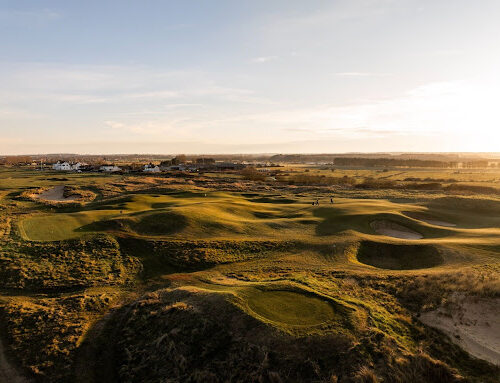An honours board commemorating those that have broken 80, or kept the same ball in play all the way round. A course that is famed for its difficulty and an obscenely small membership (as low as 3 if some rumours are to be believed), Les Bordes has been the stuff of legend and mystique for many years. More recently however with events like The Bridges Cup and the addition of a second course (The New) by Gil Hanse, this club is creating a fresh history of its own.

Not surprisingly then, when an invitation came through to visit and see the estate that Baron Marcel Bich (pen, lighter and razor magnate) called home many years ago, we leapt at the chance.
What was possibly a more austere setting back then with only one course designed by Robert Von Hagge, now sits the same classical French gite clubhouse which has been given the full treatment inside by the same team who work with Soho House creating a cool vibe with open fireplaces, soft furnishings and a reassuringly luxurious feel. An imposing stag head hangs above the fireplace, which also serves as the clubs logo. Lodges have been renovated, and limited numbers of high-end residential real-estate is now being developed as they open their doors to the rich and famous for membership.

The charismatic Robert who changed his name from Hagge to Von Hagge.
With the much talked about New Course which has jumped straight into the Golf.com World Top 100 rankings as well as the addition of the short course – ‘The Wild Piglet’ – courtesy of Gil Hanse, The Old Course (1986) at Les Bordes remains and sits within close proximity to the clubhouse. A product of a previous era of golf course design, The Old provides the most exacting test you can imagine, with artistic man made touches to the bunkering, the mounding and contours and of course the shots over huge expanses of water. The architect – Robert Von Hagge – who raised the course out of the swampy lowlands on the estate poured years of time and a blockbuster budget into the building of the course and in the words of Baron Bich after declaring a cost of >$1m to build the short par 3 4th hole;
‘Robert, you had an unlimited budget and somehow you’ve managed to go over it’
Adopted son of Ben Hagge who was an associate and landscaper for a number of architects across America including Donald Ross, Robert was a colourful and charismatic character. Around golf from a young age and the product of country club life, he began his tutelage working for Dick Wilson, a rival architect to the much renowned Robert Trent Jones.
His work is from an era and school of architecture we are quick to lambast in today’s world where reverential restorations, natural landscapes and ‘width and angles’ are the recognised gold standard. Many of his courses will be unfamiliar to many of our British readership, Boca Rio in Florida (described as ‘a course built to defend par’) was lauded as spectacular when it opened in the early days of his solo career which grew to demand offices all over the world. All told, Von Hagge worked on over 250 courses, either designing or renovating in the US and all over the world.
The course begins in front of the watchful gaze of the low slung French clubhouse. A tee perched at the water’s edge, playing out over the water banked by reeds and rushes. Confirmation of the challenge that awaits is immediate with mounding left, trees right and an island green surrounded by sand.

The 1st Green on the Old at Les Bordes
Von Hagge was a firm believer in beauty. He was adamant that a visual feast was what the golfer wanted, and instead of working with natural landforms he sought to ‘do more’ to create something truly unique with the help of earth movement, water hazards and unique features. Obsessed with light and how it changes at the extremities of the day, the fairways and surrounds at the Old Course are full of humps, hollows and dells which give the course a completely unique aesthetic especially in the setting sun. The first green when you arrive, looks almost like a female head from the air and the chevrons which flank the 15th fairway are undoubtedly the work of human hand.
Until recently the course record at The Old was 71 (set by Jean van der Velde) and stood for many years, however more recently the course has been softened and playability has improved with more generous mowing lines. Don’t get carried away thinking this is now a simple course from tee to green, with ‘easy bogeys & hard pars’. It is a serious test of ball striking, and despite the recent rough management meaning there is at least a fighting chance of retrieving a ball from an errant shot, keeping the ball in play is still the focus of your attention.
The holes which work around the water’s edge may be the most visually dramatic, the corner of the course around 7 & 8 alongside the water is truly spectacular. The 7th hole, a sweeping dogleg par 5 before a sumptuous shot back across the water for the par 3 8th are both exciting and ultim

A view of 12 through 15 at The Old
ately heroic. However, it is the holes like 6 that stick most fondly in the memory. A long expanse of sand straddles the right portion of the fairway before an approach played across an ancient monument to a wickedly contoured green where you pray you’ll find the putting surface in two.
Holes like the 14th might be as tough as anyone could imagine. Stroke index one, playing north of 550 yards from the back with water right, bunkers everywhere and heavy rough left there is simply no miss off the tee. Once you have navigated the first 400 yards and remain in the hole, you’re still left with a shot into an island green, where holding the front to back graded surface is anything but simple.

The island green on the 14th.
The Old course reminded me of the courses that we all used to sketch onto our notebooks in science classes when we were 10 years of age. A course of imagination, flair, flamboyance and an example of what a course would look like if you tore the rule book up and just went for it. The Old isn’t necessarily a course you could play everyday, it would leave you a gibbering wreck more often than not, but it would certainly improve your game in the long term if you did.
It’s an examination of your ball striking, your nerve and also your ability to make rational decisions in an environment of complete sensory overload. Decision making is binary, often between a high-tariff shot and keeping the ball in play, a golfers version of Blackjack. It might not be what modern architecture is celebrating, and at times the challenge may border on the sadistic but it’s an incredible experience, which will spark more conversation after your round and create more emotions throughout it than you will have likely experienced before.
It’s a rollercoaster of trepidation, elation, disappointment and frustration. The full gambit of emotions no matter how good you are. It’s definitely a break from the norm, and we think that can only be a good thing.






